
RFLink
FREE - Easy to use - More protocols than any other solution - Multiple frequencies - Multiple home automation platforms
RFLink: Stay Tuned!
03-12-2024
A new RFLink version will be available soon...

RFLink: New Release!
12-01-2024
RFLink release 51 is now available on the downloads page.
Note that for the integration of new devices I mostly have to rely on your debug logs and test results.
I simply cant purchase each and every device for testing, you are free to donate devices though (alternatively make a donation so I can try to purchase the device locally).
If you have any device that works but is not listed as working on our site then let me know.
If you have devices that are not working I would like to receive debug data and ask for your availability for testing. Either via mail or Telegram chat.
Automating your home often seems to be a challenge. Overall it appears to be a complicated task, it is expensive, you need a lot of technical knowledge and a lot of time. However, it does not have to be that way!!
Below is a recipe for a great system that has everything a beginner needs, but also offers flexibility to expand to one of the best systems currently available. We use Domoticz, the leading, free and open-source home automation software, to control hardware that communicates on 433 mhz. Devices that use this frequency are light switches, weather sensors, sunscreen controllers, door and window contacts and many more. (See the note below about frequencies and possibilities)
Note: we are working on adding RFLink Gateway support to other Home Automation platforms as well!
Right now you can use the RFLink gateway at least with the following Home Automation software:
Domoticz Native support
HomeAssistant Native support
Jeedom Requires a plugin
Pimatic Requires a plugin
Domotiga Native support
OpenHAB Requires a binding
HoMIDoM Requires a driver
Hardware Shopping List:
Base system: (Complete Home Automation controller)
- Raspberry Pi (Around 40 Euros)
- Arduino Mega (Around 37 Euros, only 10 euros when purchased from Aliexpress)
- RFLink Gateway board (starting at 20 Euros, purchase now at the Nodo webshop)
- SD Card (for best results use a class 10 card) (4Gb class 10 = around 7 euros)
Total price: ~ 87,50 Euros Complete special set, order now!

Optional items to purchase (you might even own some already!):
- wall light switch set(s) (like Klik Aan or Chacon)
- temperature sensor(s)
- door/window contact(s)
- doorbell(s)
Often you already own devices that communicate on 433 mhz. like an indoor weather station that has an outdoor sensor.
A wireless doorbell or a remote controlled lamp switch
RFlink's task is to grab the transmitted signals from the air and notify Domoticz with the details.

Required (Free) Software:
- Domoticz Home Automation software Domoticz software
- RFLink Gateway software RFLink software
Step 1:
Download the latest Domoticz SD Card image.
Step 2:
Write the Domoticz image to the SD Card.
A clear instruction on how to install the Domoticz software to the SD Card is provided within the archive.
Step 3:
Download the RFLink Loader,
connect the Arduino MEGA to the PC and
run the loader.
Select the "rflink.cpp.hex" file or with later releases the "rflink.ino.hex" file,
select the correct serial port to which the Arduino is connected and
press the Upload button.
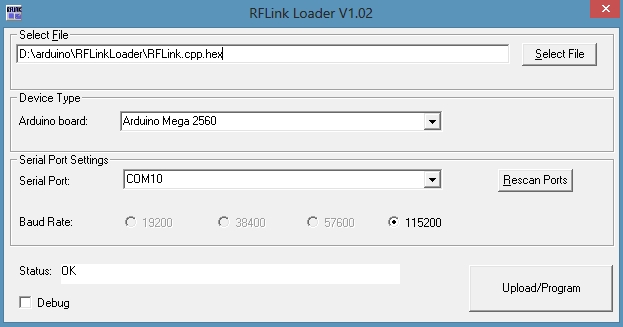
Step 4:
Connect the RFlink gateway board to the Arduino Mega.
Alternatively, attach RF modules following the included circuit diagram to the Arduino Mega.
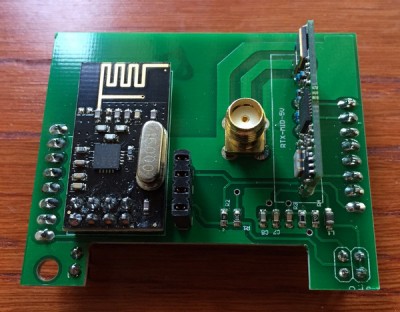
Step 5:
Connect the Arduino with a USB cable to the Raspberry Pi

Step 6:
Connect the Raspberry Pi to a decent power supply and power on
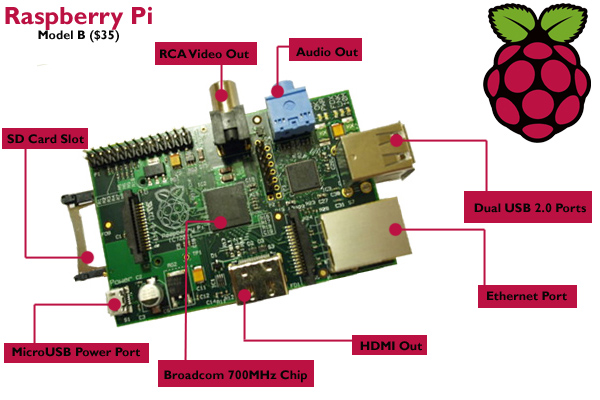
Stap 7:
Surf with a browser to the Domoticz dashboard and choose under the settings tab for hardware
Stap 8:
Add a new device with the type RFLink Gateway USB and make it active
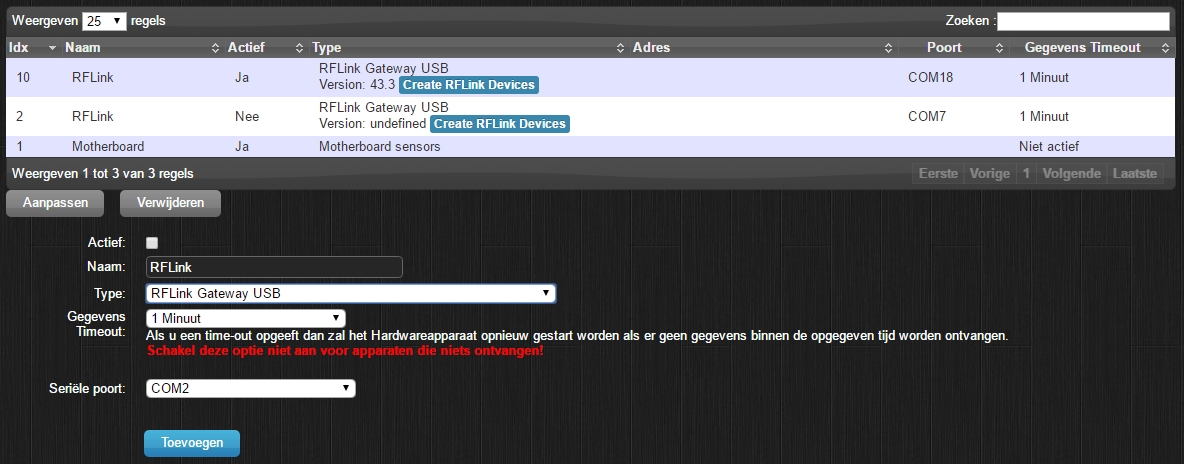
Stap 9:
Under the settings tab, choose devices and discover the wireless devices that the RFLink has detected like wireless weather stations, security sensors, light switches etc...
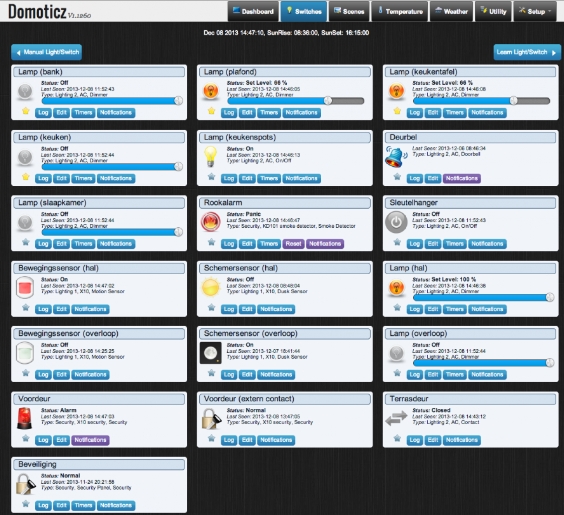
Note about frequencies:
In the above setup, 433 mhz support is chosen. In some areas this frequency might be overcrowded and reception problems could occure.
Alternatives are the 868 mhz frequency and 2.4 ghz frequency. Each having their own pro's and con's. The best solution is probably a mixture of frequencies.
On top of that there are other protocols like ZWave, Zigbee and even wired solutions that could be considered. Usually these are more expensive.
The 433 mhz frequency devices are cheap and it offers an easy entrance into the home automation world. Also it can be combined later on with ZWave and 2.4 Ghz communication.
The current version of the RFLink firmware also supports communication via 2.4Ghz.
The current version of the RFlink firmware also support reception at 868 and 915 mhz.
The current version of the RFlink firmware also support reception and transmission at 315 mhz.

